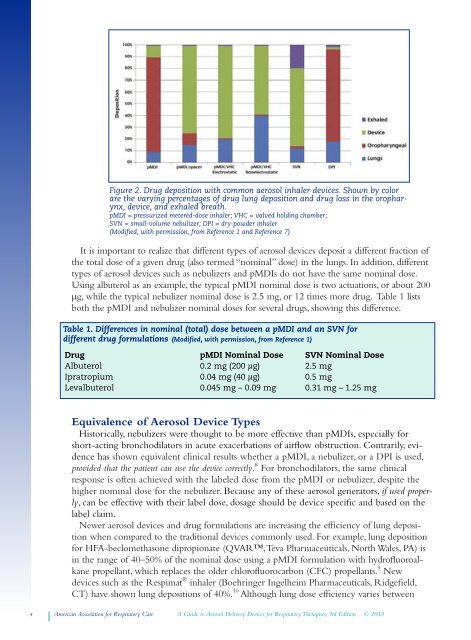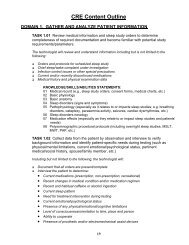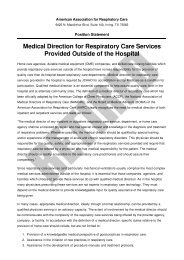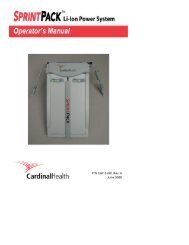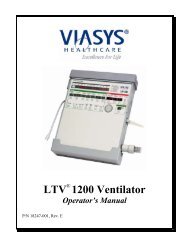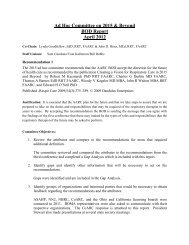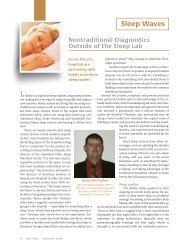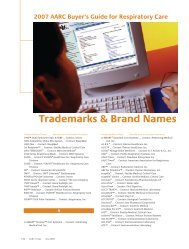Aerosol Guide - AARC.org
Aerosol Guide - AARC.org
Aerosol Guide - AARC.org
You also want an ePaper? Increase the reach of your titles
YUMPU automatically turns print PDFs into web optimized ePapers that Google loves.
Figure 2. Drug deposition with common aerosol inhaler devices. Shown by color<br />
are the varying percentages of drug lung deposition and drug loss in the oropharynx,<br />
device, and exhaled breath.<br />
pMDI = pressurized metered-dose inhaler; VHC = valved holding chamber;<br />
SVN = small-volume nebulizer; DPI = dry-powder inhaler<br />
(Modified, with permission, from Reference 1 and Reference 7)<br />
It is important to realize that different types of aerosol devices deposit a different fraction of<br />
the total dose of a given drug (also termed “nominal” dose) in the lungs. In addition, different<br />
types of aerosol devices such as nebulizers and pMDIs do not have the same nominal dose.<br />
Using albuterol as an example, the typical pMDI nominal dose is two actuations, or about 200<br />
µg, while the typical nebulizer nominal dose is 2.5 mg, or 12 times more drug. Table 1 lists<br />
both the pMDI and nebulizer nominal doses for several drugs, showing this difference.<br />
Table 1. Differences in nominal (total) dose between a pMDI and an SVN for<br />
different drug formulations (Modified, with permission, from Reference 1)<br />
Drug pMDI Nominal Dose SVN Nominal Dose<br />
Albuterol 0.2 mg (200 μg) 2.5 mg<br />
Ipratropium 0.04 mg (40 μg) 0.5 mg<br />
Levalbuterol 0.045 mg – 0.09 mg 0.31 mg – 1.25 mg<br />
Equivalence of <strong>Aerosol</strong> Device Types<br />
Historically, nebulizers were thought to be more effective than pMDIs, especially for<br />
short-acting bronchodilators in acute exacerbations of airflow obstruction. Contrarily, evidence<br />
has shown equivalent clinical results whether a pMDI, a nebulizer, or a DPI is used,<br />
provided that the patient can use the device correctly. 8 For bronchodilators, the same clinical<br />
response is often achieved with the labeled dose from the pMDI or nebulizer, despite the<br />
higher nominal dose for the nebulizer. Because any of these aerosol generators, if used properly,<br />
can be effective with their label dose, dosage should be device specific and based on the<br />
label claim.<br />
Newer aerosol devices and drug formulations are increasing the efficiency of lung deposition<br />
when compared to the traditional devices commonly used. For example, lung deposition<br />
for HFA-beclomethasone dipropionate (QVAR, Teva Pharmaceuticals, North Wales, PA) is<br />
in the range of 40–50% of the nominal dose using a pMDI formulation with hydrofluoroal -<br />
kane propellant, which replaces the older chlorofluorocarbon (CFC) propellants. 9 New<br />
devices such as the Respimat ® inhaler (Boehringer Ingelheim Pharmaceuticals, Ridgefield,<br />
CT) have shown lung depositions of 40%. 10 Although lung dose efficiency varies between<br />
4 American Association for Respiratory Care A <strong>Guide</strong> to <strong>Aerosol</strong> Delivery Devices for Respiratory Therapists, 3rd Edition © 2013


